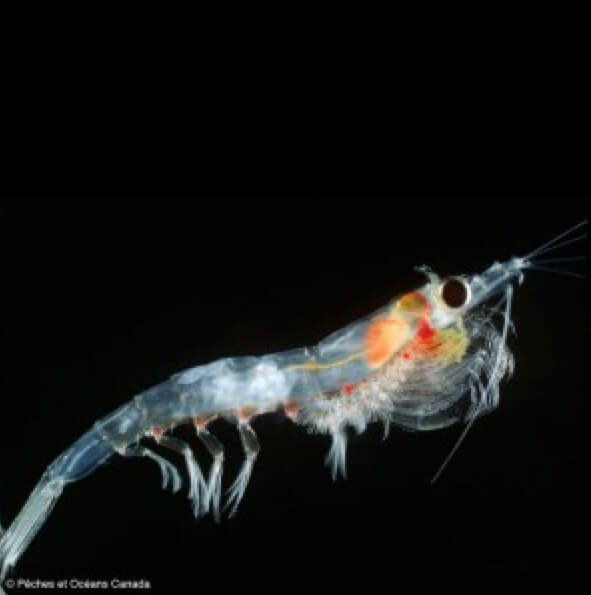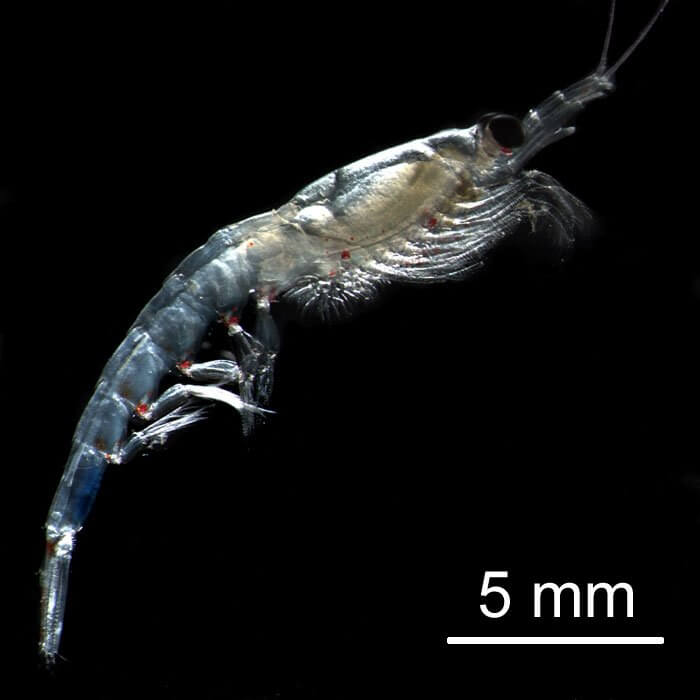In summer, the St. Lawrence is a feeding ground for a number of blue whales of the northwest Atlantic population. They feed exclusively on krill, consuming up to an estimated four tonnes a day of these tiny planktonic crustaceans that live in swarms. If, of course, the ecosystem allows. Are they really eating enough to accumulate sufficient energy to survive the winter fast and to reproduce? Is it due to a lack of food that this population of blue whales is endangered?
In an attempt to answer these questions, Fisheries and Oceans Canada researchers and their collaborators have measured krill density in the St. Lawrence. But how does one know if these densities are sufficient? By creating a mathematical model to calculate energy expenditure and energy gains on the basis of krill density. The following are some of the questions that researchers had to answer in order to build the model.
How much energy is spent per bite?
In a single gulp, a blue whale can engulf 70,000 litres of water in its elastic mouth, i.e. the equivalent of its own weight. It goes without saying that this feeding technique comes with a tremendous cost in terms of energy. If the gulps take place in deep water, one must also consider the energy expenses related to diving. Even rest periods between meals involve energy costs associated with breathing and maintaining body temperature, amongst other bodily functions.
How much energy is obtained per bite?
The energy intake of each mouthful depends primarily on the density of the krill being targeted, i.e. the size of the bite. Additionally, not all krill species in the St. Lawrence have the same nutritional value: Northern krill is 20% richer in energy than Arctic krill.
How is all this measured?
Researchers tracked 10 individuals with telemetric tracking devices that record the animals’ speed and depth during diving and feeding activities. These data can then be used to estimate the energy expenditures of these activities based on knowledge of such expenditures in large land mammals and smaller marine mammals.
The density of ten krill swarms in proximity to feeding blue whales was measured using an echo sounder. This device emits sound waves that bounce off the krill and are then picked up as an echo.
What krill density is needed in order to accumulate energy?
According to the theory of optimal foraging, a concept used in ecology, animals have evolved to minimize their energy costs related to foraging and feeding while maximizing the energy obtained from the food they consume. And blue whales are no exception: in the following video, a blue whale engulfs the highest-density krill swarm, but ignores the smaller swarm, probably because the energy gains would not offset the energy expenditure.
When gains exceed expenditures, blue whales can store additional energy for migration, winter fasting and breeding. How much energy do they need to set aside for all these future activities? Since quantifying the energy required for these functions in an animal as large as a blue whale is complex, similar data for other marine mammal species can be used. For example, in fur seals, energy gains are 3 times higher than expenditures in a growing population, but only 2 times higher in a declining population.
Are krill swarms in the St. Lawrence dense enough?
To compensate for energy expenditure, a a 25-metre-long blue whale should target a minimum krill density of 11 to 40 g/m3, a figure that varies depending on the species of krill and the depth of the swarm. This density condition is met in 12% of the Arctic krill swarms and 5.5% of the Northern krill swarms analyzed. Moreover, about 1.5% of the krill swarms analyzed would yield gains three times higher than expenditures.
“To accumulate energy, blue whales must target the highest densities within a swarm of krill,” concludes Marie Guilpin, lead author of the study. According to a previous study, when they target lower-density swarms, blue whales seem to use more manoeuvres to gather their prey, which might increase their actual density. The tags used in this study did not have the right kinds of sensor to study this type of feeding behaviour.
Several researchers suspect that the birth rate in this population is low, with only 28 sightings of blue whale calves in the St. Lawrence in the past 40 years. Low energy accumulation linked to insufficient krill density might be a contributing factor to reproductive problems. Indeed, in a context of insufficient energy, the essential functions for survival are preserved while reproduction is neglected. For the time being, the link between excessively low energy accumulation and a low birth rate is only hypothetical.
Before drawing any conclusions regarding a potential shortage of food, additional types of data should be included in the model such as energy expenditures related to migration, pregnancy and nursing. Additionally, the model did not consider other feeding areas that blue whales may visit or hunting stops during migration. Lastly, Marie Guilpin also wants to include the influence of boat disturbance in the model. “When a boat is within 400 metres of a blue whale, average dive times fall from 10 minutes to 4 minutes. How much energy can they stock up on then?” she wonders.









